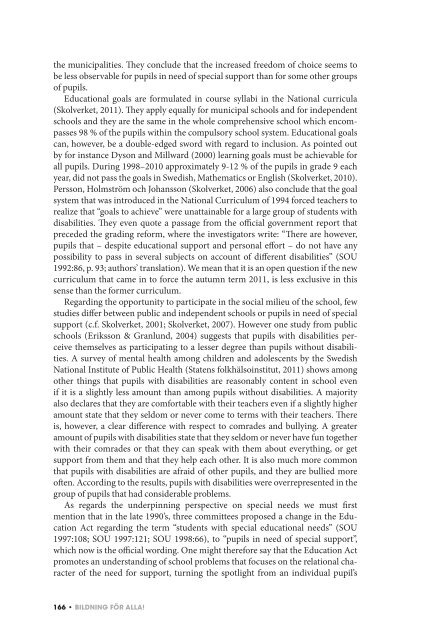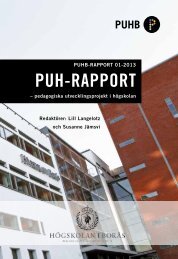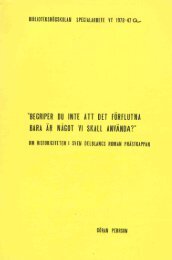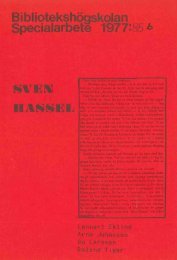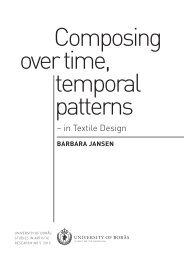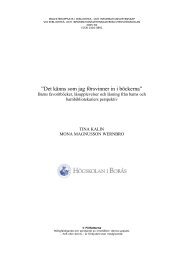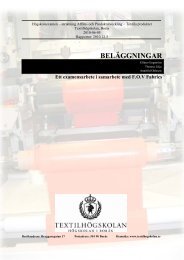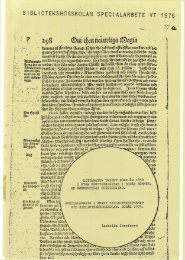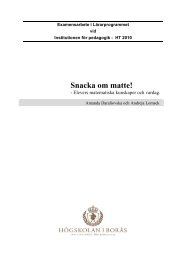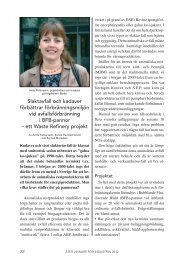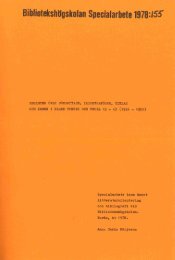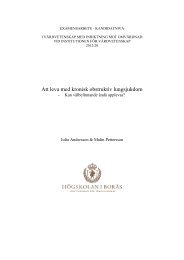Bildning för alla! - DiVA
Bildning för alla! - DiVA
Bildning för alla! - DiVA
Create successful ePaper yourself
Turn your PDF publications into a flip-book with our unique Google optimized e-Paper software.
the municipalities. They conclude that the increased freedom of choice seems to<br />
be less observable for pupils in need of special support than for some other groups<br />
of pupils.<br />
Educational goals are formulated in course syllabi in the National curricula<br />
(Skolverket, 2011). They apply equally for municipal schools and for independent<br />
schools and they are the same in the whole comprehensive school which encompasses<br />
98 % of the pupils within the compulsory school system. Educational goals<br />
can, however, be a double-edged sword with regard to inclusion. As pointed out<br />
by for instance Dyson and Millward (2000) learning goals must be achievable for<br />
all pupils. During 1998–2010 approximately 9-12 % of the pupils in grade 9 each<br />
year, did not pass the goals in Swedish, Mathematics or English (Skolverket, 2010).<br />
Persson, Holmström och Johansson (Skolverket, 2006) also conclude that the goal<br />
system that was introduced in the National Curriculum of 1994 forced teachers to<br />
realize that “goals to achieve” were unattainable for a large group of students with<br />
disabilities. They even quote a passage from the official government report that<br />
preceded the grading reform, where the investigators write: “There are however,<br />
pupils that – despite educational support and personal effort – do not have any<br />
possibility to pass in several subjects on account of different disabilities” (SOU<br />
1992:86, p. 93; authors’ translation). We mean that it is an open question if the new<br />
curriculum that came in to force the autumn term 2011, is less exclusive in this<br />
sense than the former curriculum.<br />
Regarding the opportunity to participate in the social milieu of the school, few<br />
studies differ between public and independent schools or pupils in need of special<br />
support (c.f. Skolverket, 2001; Skolverket, 2007). However one study from public<br />
schools (Eriksson & Granlund, 2004) suggests that pupils with disabilities perceive<br />
themselves as participating to a lesser degree than pupils without disabilities.<br />
A survey of mental health among children and adolescents by the Swedish<br />
National Institute of Public Health (Statens folkhälsoinstitut, 2011) shows among<br />
other things that pupils with disabilities are reasonably content in school even<br />
if it is a slightly less amount than among pupils without disabilities. A majority<br />
also declares that they are comfortable with their teachers even if a slightly higher<br />
amount state that they seldom or never come to terms with their teachers. There<br />
is, however, a clear difference with respect to comrades and bullying. A greater<br />
amount of pupils with disabilities state that they seldom or never have fun together<br />
with their comrades or that they can speak with them about everything, or get<br />
support from them and that they help each other. It is also much more common<br />
that pupils with disabilities are afraid of other pupils, and they are bullied more<br />
often. According to the results, pupils with disabilities were overrepresented in the<br />
group of pupils that had considerable problems.<br />
As regards the underpinning perspective on special needs we must first<br />
mention that in the late 1990’s, three committees proposed a change in the Education<br />
Act regarding the term “students with special educational needs” (SOU<br />
1997:108; SOU 1997:121; SOU 1998:66), to “pupils in need of special support”,<br />
which now is the official wording. One might therefore say that the Education Act<br />
promotes an understanding of school problems that focuses on the relational character<br />
of the need for support, turning the spotlight from an individual pupil’s<br />
166 • BilDning fÖr AllA!


